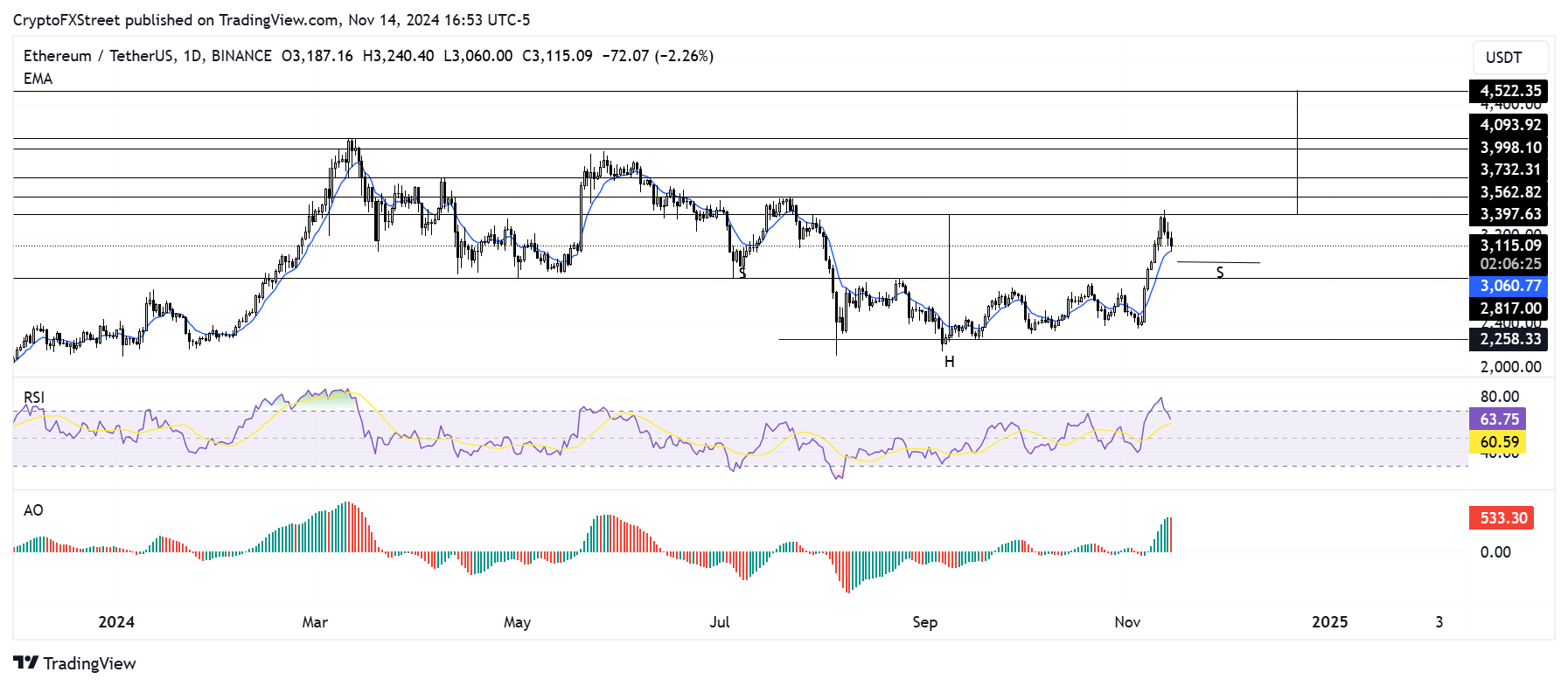Ethereum Price Forecast: ETH could rally to $4,522 despite mixed on-chain flows among investors
Ethereum price today: $3,110
- Ethereum ETFs recorded six consecutive days of positive flows after posting net inflows of $146.9 million on Thursday.
- Investors have unstaked over $300 million worth of ETH in the past 48 hours.
- Ethereum could rally to $4,522 if the inverted head and shoulders pattern develops.
Ethereum (ETH) is down over 1% on Thursday following record net inflows across ETH exchange-traded funds (ETF) in the past six days. Despite the bullish market outlook, $300 million worth of unstaked ETH could hit the market and cause downward pressure on prices.
Ethereum investors display mixed on-chain behavior
Ethereum ETFs are on track to record their best week since launch after posting net inflows of $146.9 million on Wednesday, per Coinglass data. This marks a sixth consecutive day of positive flows for the products, stretching their six-day flows to $796.2 million.
Notably, the recent inflows have sent ETH ETF total net flows to $241.7 million — positive for the first time since launch.
This aligns with on-chain data which reveals that Ethereum whales have been dominating the market this week, with the daily count of large transactions — higher than $100,000 — surpassing 10,000 for the first time since August.

ETH Total Number of Large Transactions | IntoTheBlock
However, investors need to be cautious of ETH's exchange reserve, which has been trending upward. A rising exchange reserve indicates a potential increase in selling pressure.
Additionally, ETH staking flows show a net outflow of 94.4K ETH worth over $300 million in the past 48 hours, per IntoTheBlock's data. ETH could see a decline if the supply pressure from the staking outflows hit the market.

ETH Staking Flows | IntoTheBlock
Meanwhile, asset manager Franklin Templeton extended its US Government Money Fund (FOBXX) to the Ethereum blockchain on Thursday. FOBXX enables investors to buy shares of government securities and repurchase agreements, and hold them in crypto wallets via Franklin's Benji investment app.
Ethereum Price Forecast: ETH could rally to $4,522
Ethereum is trading near $3,110 following $57.34 million in liquidations in the past 24 hours, per Coinglass data. Liquidated long and short positions accounted for $34.13 million and $23.20 million, respectively.
ETH bounced off the 14-day Exponential Moving Average (EMA) in blue after selling pressure near the $3,400 level extended its decline to a third consecutive day.

ETH/USDT daily chart
Since the bounce off the EMA, the top altcoin appears to be on the verge of posting an inverted head-and-shoulders pattern. If ETH follows this pattern, it could flip its yearly high resistance of $4,093 and rally toward $4,522.
The 14-day Relative Strength Index (RSI) is trending downward and looking to cross below its yellow moving average line. If it completes this move, ETH could decline toward $2,817.
A daily candlestick close below $2,817 will invalidate the bullish thesis.
Ethereum FAQs
Ethereum is a decentralized open-source blockchain with smart contracts functionality. Its native currency Ether (ETH), is the second-largest cryptocurrency and number one altcoin by market capitalization. The Ethereum network is tailored for building crypto solutions like decentralized finance (DeFi), GameFi, non-fungible tokens (NFTs), decentralized autonomous organizations (DAOs), etc.
Ethereum is a public decentralized blockchain technology, where developers can build and deploy applications that function without the need for a central authority. To make this easier, the network leverages the Solidity programming language and Ethereum virtual machine which helps developers create and launch applications with smart contract functionality.
Smart contracts are publicly verifiable codes that automates agreements between two or more parties. Basically, these codes self-execute encoded actions when predetermined conditions are met.
Staking is a process of earning yield on your idle crypto assets by locking them in a crypto protocol for a specified duration as a means of contributing to its security. Ethereum transitioned from a Proof-of-Work (PoW) to a Proof-of-Stake (PoS) consensus mechanism on September 15, 2022, in an event christened “The Merge.” The Merge was a key part of Ethereum's roadmap to achieve high-level scalability, decentralization and security while remaining sustainable. Unlike PoW, which requires the use of expensive hardware, PoS reduces the barrier of entry for validators by leveraging the use of crypto tokens as the core foundation of its consensus process.
Gas is the unit for measuring transaction fees that users pay for conducting transactions on Ethereum. During periods of network congestion, gas can be extremely high, causing validators to prioritize transactions based on their fees.

